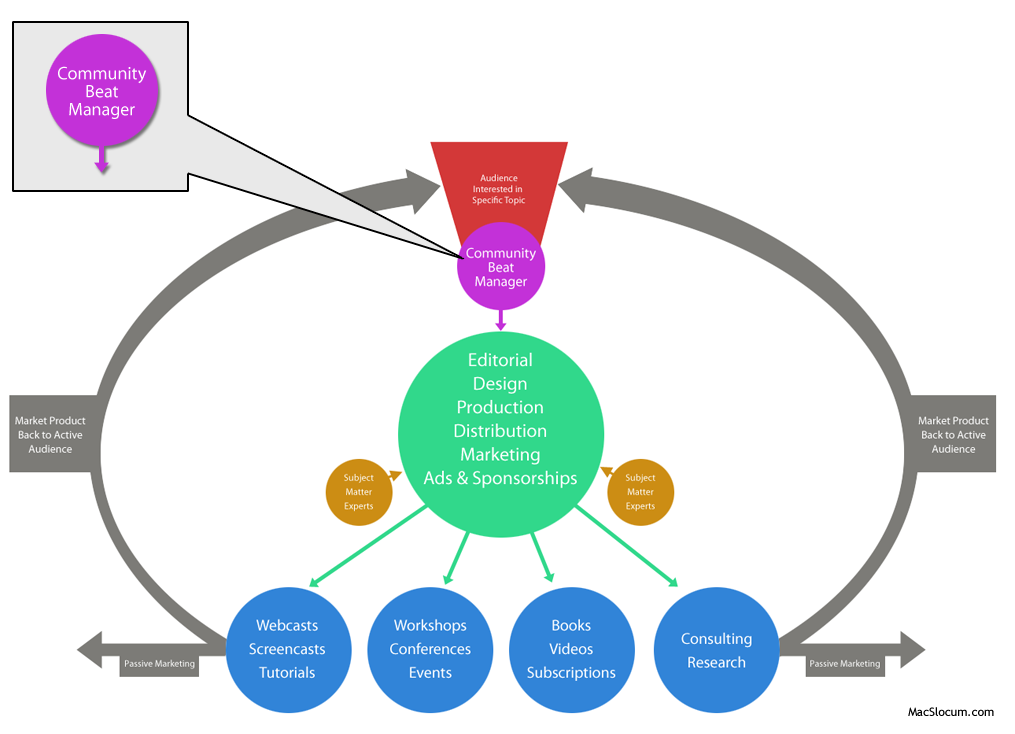The ideal community beat manager has a reporter's thirst for information, a party host's conversation skills, and a passion for his/her topic.
That word -- "passion" -- gets thrown around a lot in online circles. I don't use it lightly. There are very few things I'm passionate about, and I guard them like an overprotective parent. I love these topics. I want to make them stronger and better. And most important of all, I want to share my interest with other folks.
Requiring passion is a tall order, but there's no replacement. A half-hearted attempt isn't good enough because a disruptive competitor motivated by passion can create value by delivering more coverage. And "more" is easy if you love what you do.
Remember this: Passion is the scarcest resource in this entire model. Treat it with respect.
Now, lets pluck our heads from the billowy clouds and talk about the day-to-day responsibilities of this passion-driven community beat manager:
| % of Weekly Allocated Time | Activity |
| 75% | Community interaction via blog posts, tweets, social networks, posting/responding to comments. These are vital activities that cannot be ignored. |
| 15% | Assist the in-house editorial group with long-term projects targeting the community beat manager's core audience. This can involve brainstorming, editing and event planning. (Note: these long-term projects are overseen by the in-house editorial group. The community beat manager acts as a consultant/external resource for these products.) |
| 10% | Discussion with the editorial director to share the latest themes, trends and needs of the target community. An open line of communication between the community beat manager and the in-house editorial group is an essential component of this model. Ideas need to flow freely from both sides. |
Defining the Community Beat Manager's Role (and Protecting that Role)
Because the majority of the community beat manager's time is allocated to "soft" development (community outreach, blog writing/editing, inbound marketing, etc.) the need for these positions will undoubtedly be questioned within the in-house editorial group. Someone within that group, preferably the editorial director, needs to reinforce the importance of the community beat managers. This model will not function without these managers and the managers should not be distracted by "hard" development of traditional products (books, reports, for-pay content). Their role in any long-range products should be as consultants or assistants, not leads. The community beat managers are the lifeline to the audience, and without the audience you've got nothing.
Community Beat Manager Costs and Realities
Peer recognition and personal satisfaction are lousy long-term motivators. You need to open the corporate checkbook if you want community beat managers to commit. The following is a sample payment model:
| Contract Type |
% of Weekly Time | Compensation |
| Part-time, level I | Less than 50% | Minimum of $750 per month plus limited travel coverage to 3 industry events per year. |
| Part-time, level II | 51-89% | Minimum of $1,500 per month plus limited travel coverage to 5 industry events per year |
| Full time | 90-100% | Minimum of $4,000 per month plus limited travel coverage to 7 industry events per year. |
Given the fluctuations in online communities and topics, as well as the prerequisite for passionate coverage, community beat managers should be independent contractors on month-to-month contracts. It doesn't make sense to hire salaried employees and take on significant infrastructure costs when your community efforts require targeting, experimentation and agility.
The Community Beat Manager's Toolbox
Blog -- The blog is the hub of the community and it needs to be fed and groomed every weekday. Coverage can vary depending on the community beat manager's talents and interests. Original reporting, aggregation/curation, interviews, and community discussions are all acceptable as long as they focus on value-creation for the audience.
RSS feeds -- Full content feeds will be made available and publicized.
Newsletter -- An auto-generated newsletter (or newsletters) will be offered via the RSS feeds. Hand-edited newsletters are an option if the effort can be justified.
Twitter-- The Twitter account will be owned by the company, branded by the company, and associated with the current beat manager. The account will change hands if/when a new community beat manager is hired. The beat manager can use a personal Twitter account as a secondary publicity mechanism, but this is voluntary.
LinkedIn, Facebook, Ning, FriendFeed and other platforms -- The community beat manager will work with the in-house editorial group to create and manage presences on various social networks. Most of these services can automatically redistribute content via RSS feeds. Custom discussion topics and content will be created for platforms with high activity.

Leave a comment